ENRIQUE MARTINEZ CUBELLS (Madrid, 1874 - Málaga, 1947). "Marina". Oil on canvas.
Lot 14
About Seller
Setdart Auction House
Carrer Aragó 346
Barcelona
Spain
Setdart Subastas was born in 2004 and is currently the first online art auction in Spain with solidity, prestige and reliability guaranteed by our more than 60,000 users. Setdart has a young, dynamic and enterprising team ready to successfully manage the purchase and sale of art works through custom...Read more
Estimate:
EUR€1,200 - EUR€1,500
$1,250 - $1,562.50
Absentee vs Live bid
Two ways to bid:
- Leave a max absentee bid and the platform will bid on your behalf up to your maximum bid during the live auction.
- Bid live during the auction and your bids will be submitted real-time to the auctioneer.
Bid Increments
| Price | Bid Increment |
|---|---|
| EUR€0 | EUR€10 |
| EUR€200 | EUR€25 |
| EUR€500 | EUR€50 |
| EUR€1,000 | EUR€100 |
| EUR€3,000 | EUR€200 |
| EUR€5,000 | EUR€500 |
| EUR€10,000 | EUR€1,000 |
| EUR€20,000 | EUR€2,000 |
| EUR€50,000 | EUR€5,000 |
About Auction
By Setdart Auction House
Dec 14, 2021
Set Reminder
2021-12-14 08:00:00
2021-12-14 08:00:00
America/New_York
Bidsquare
Bidsquare : 19th & 20th Century Fine Art
https://www.bidsquare.com/auctions/setdart-auction-house/19th-20th-century-fine-art-7992
Gaudi, Sorolla, Torres Garcia, Maclet, TSUGUHARU FOUJITA, Benjamin Palencia Setdart Auction House sofia@setdart.com
Gaudi, Sorolla, Torres Garcia, Maclet, TSUGUHARU FOUJITA, Benjamin Palencia Setdart Auction House sofia@setdart.com
- Lot Description
ENRIQUE MARTINEZ CUBELLS (Madrid, 1874 - Málaga, 1947). "Marina". Oil on canvas. Signed in the lower right corner. Measurements: 37 x 44 cm; 58 x 63 cm (frame). Son of the Valencian painter Salvador Martínez Cubells, he begins his formation in the paternal workshop, to later continue his studies in the School of Arts and Trades of Madrid and in the Special School of Painting, Sculpture and Engraving of the same city. His style was freed from his father's influence after a trip to Europe in 1898. His admiration for German modern art led him to settle in Munich for four years, and later he made stays in Venice, Paris and Amsterdam. In his travels through Europe, Martínez-Cubells received an important influence from European realist currents, at a time when his Spanish contemporaries were still making history paintings. His personal style was characterized by bold and synthetic brushstrokes, in addition to his great interest in the luminous aspects. More Nordic and austere than his Spanish colleagues, his conception of light is contained and intimate, far from the blinding force of Sorolla. On his return to Spain, he was appointed professor at the Schools of Arts and Crafts and San Fernando in Madrid. He participated assiduously in the National Exhibitions of Fine Arts, obtaining the third medal in 1897, second in 1899 and 1901, and first in 1904 and 1912. The works that earned him these first medals were "Work, Rest and Family", in 1904, and "The Return from Fishing", in 1912. Subsequently, he was awarded a first medal at the Buenos Aires International Exposition of 1910, as well as a grand prize at the Panama Exposition of 1916. He later became a member of the Royal Academy of Fine Arts of San Fernando in Madrid. Between January and March 2003 Ibercaja presented in Zaragoza the first anthological exhibition dedicated to this painter. Enrique Martínez-Cubells worked mainly on genre themes of social content, often of a fishing and maritime nature, although he also showed a predilection for urban landscapes, interiors and rural peasant scenes. He is represented in the Prado Museum, the Carmen Thyssen Museum in Malaga and the Fine Arts Museums of Valencia, La Rioja, Malaga, Alava and San Sebastian, among others.
- Shipping Info
-
In-house shipping available. Please inquire at admin@setdart.com.
-
- Buyer's Premium



 EUR
EUR CAD
CAD AUD
AUD GBP
GBP MXN
MXN HKD
HKD CNY
CNY MYR
MYR SEK
SEK SGD
SGD CHF
CHF THB
THB
















